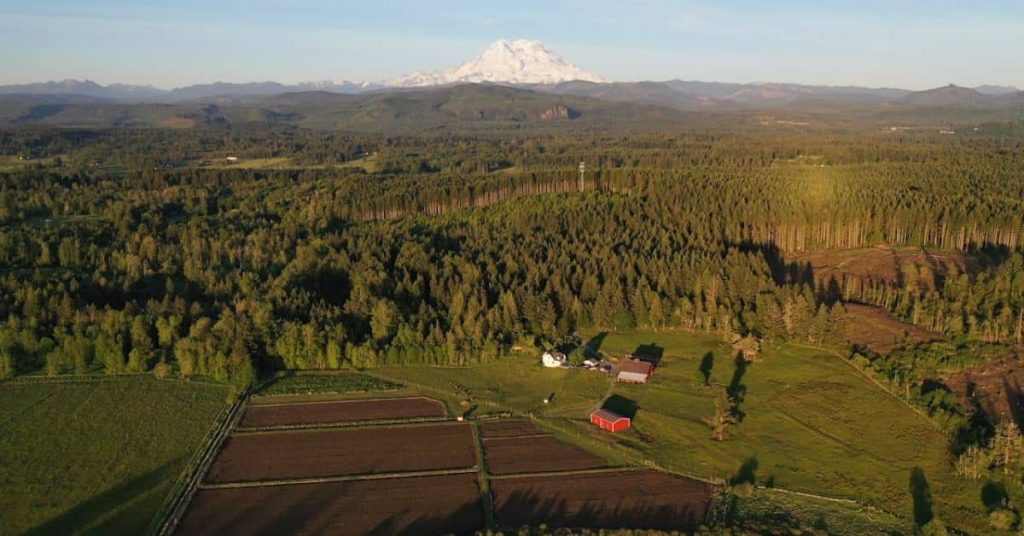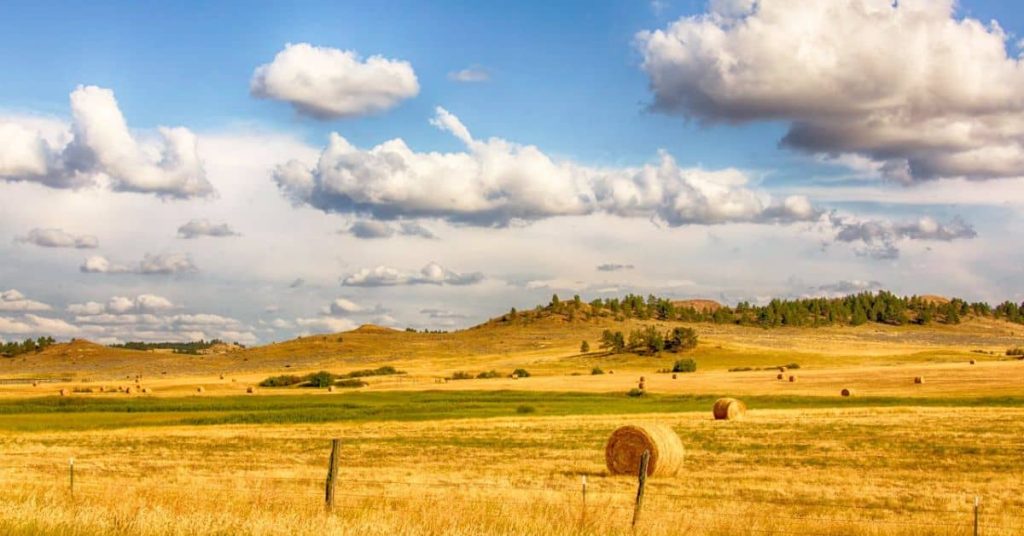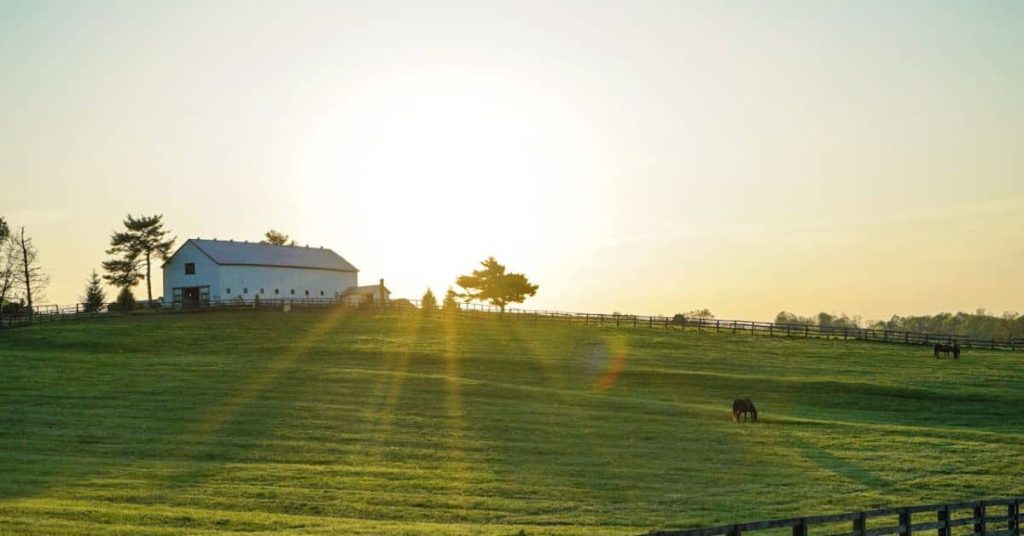Homesteading in Washington lets you raise food year-round if you match your plan to each side of the Cascades. Wet west soils love greens; the sun-baked east turns tomatoes sweet. Both regions hand you mild winters that protect livestock from deep freezes.
I proved it last April when my Skagit quarter-acre gave me 25 pounds of spinach before Memorial Day. Those early greens saved us ninety dollars at the grocery and boosted our salad habit. The kids kept count with chalk marks on the coop door. Last August the same bed yielded zucchinis the size of my forearm.
I’ve farm-steaded the Evergreen State for 12 years and hold a WSU Extension certificate in small-farm management. Stick with me and you’ll sidestep rookie fees, keep taxes down, and harvest sooner. Your future pantry will thank you.
If you’re looking for quick answers, jump into our Frequently Asked Questions (FAQ) section.
Washington Homesteading 101: Challenges & Perks
Washington splits into wet west and sunny east; know your USDA zone, claim the 2025 homestead exemption, and lock in rainwater rights before you build. Do that and you cut taxes while boosting year-round harvests.
Climate Split – Rain-Soaked West vs. Arid East (USDA 6a–8b)
Western Washington averages 60 inches of rain; I never need to irrigate spring greens. Eastern counties sit in the Cascades’ rain-shadow, so I run drip lines and mulch deep. Checking the USDA Plant Hardiness Map put my Skagit plot in zone 8b, perfect for winter kale. (USDA Plant Hardiness Zone Map)
What worked for me: Plant cool crops (spinach, peas) before April in the west; start heat lovers (tomatoes, peppers) indoors for the east.
Action Steps
- Look up your zone by ZIP on the USDA map.
- Note last-frost dates; west is late February, east can be mid-April.
- Choose seed varieties bred for your zone.
- Add two inches of compost to buffer rain or drought.
- Set up rain barrels west side, drip tape east side.
- Keep a log of soil temps for next season.
Homestead Exemption 2025: What It Really Protects
Washington shields at least $125 k of home equity from creditors, or up to the county’s median sale price if higher.
Source: Washington State Legislature hat let us refinance for barn repairs without fear of a lien.
Action Steps
- Confirm your county’s median sale price.
- File the automatic exemption form only if lender requests proof.
- Keep proof of residence (utility bill) in a fire box.
- Re-check exemption figures each January.
- Use equity savings to fund fencing, not consumer debt.
Off-Grid Legality: Water & Rainwater Rights
Catching roof water is legal statewide up to household use. A drilled well, however, needs a Department of Ecology permit if over 5 000 gpd. I stayed under that cap by installing low-flow heads and a grey-water system.
Action Steps
- Measure roof area; 1 inch rain on 1 000 sq ft nets 600 gallons.
- File a Notice of Intent for any new well.
- Install first-flush diverter on rain barrels.
- Label potable vs. garden tanks.
- Log monthly use; keep under permit threshold.
Pick Your Homestead Style: Urban, Small Acreage, or Off-Grid
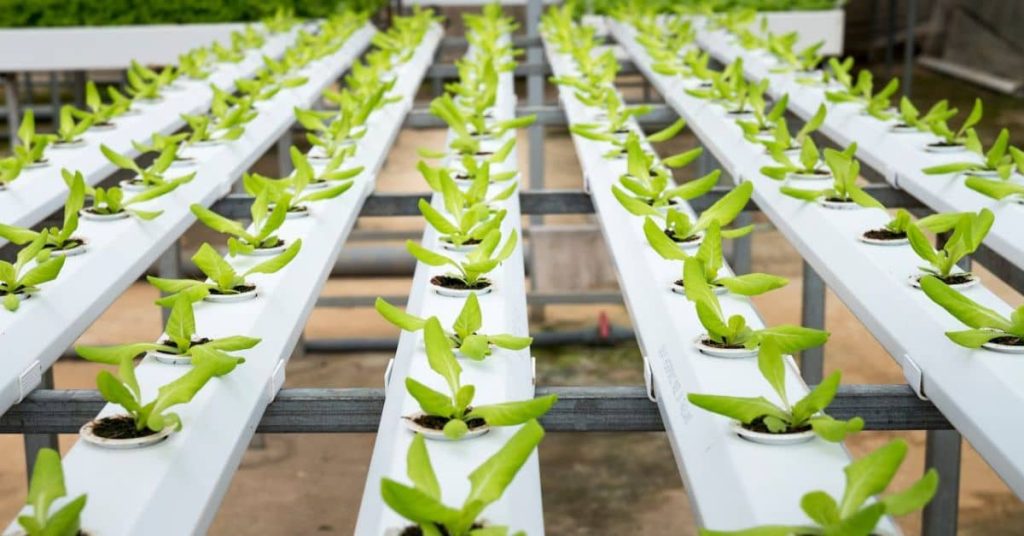
Choose rooftop pots, a 5-acre micro-farm, or an off-grid cabin; match the style to your USDA zone, budget, and flood map to thrive as a Washington homesteader.
Urban Homesteading in Seattle & Tacoma
City lots still feed families. My first year in Tacoma, six food-grade totes and one worm bin grew 80 lb of salad greens.
What worked for me: Stacking pots on a south wall for heat and rat-proof hardware cloth under each bed. Rooftop rain fills a 55-gallon barrel by March.
Small-Acreage Micro-Farm (1–5 acres) in Zone 8b
Western counties sit in USDA zone 8b; winters rarely drop below 15 °F. That lets you overwinter kale and garlic without hoops. A single acre can hold 20 dwarf fruit trees, 30 hens, and a garden that feeds four. Rotate beds yearly to beat clubroot.
Full-Scale Off-Grid in Eastern Washington’s Zone 6a
East of the Cascades, sunlight tops 250 days. My friend’s Ferry County cabin runs on a 4-kW solar array plus a hand-pump well. The trick is deep mulch, six inches of straw, so tomatoes survive 45 mph summer winds. Propane backup covers January’s cloudy streaks.
Land-Buying Checklist: Cheap Land vs. Flood-Zone Risks
- Pull FEMA flood maps before any offer; avoid Special Flood Hazard Areas.
- Walk the parcel after heavy rain to spot puddle lines.
- Confirm county zoning allows livestock and on-site sales.
- Test well depth and flow; haul-in water adds big cost.
- Check cell signal for off-grid safety.
- Budget 30 % over list price for permits and fencing.
10-Step Launch Checklist: Land, Permits & Power

Tick these ten boxes; tax class, zoning, water, soil, food permit, building papers, solar aid, temp services, fencing, market IDs, and a Washington homestead starts strong and legal.
1. Pick a County with Low Ag-Tax Rates
What worked for me: moving from Pierce to Lewis County cut our yearly bill by one-third. The state’s Current-Use Farm & Ag program values land at production, not resale.
Source: Property Tax Resource Center
Action Steps
- Download each county assessor’s “current-use” table.
- Compare per-acre rates on a spreadsheet.
- Call the assessor to confirm acreage minimums.
- File the current-use application within 30 days of closing.
- Budget four years of back taxes if you ever remove the land.
2. Confirm Zoning Allows Livestock and Sales
Many “rural residential” lots ban roosters and on-site farm stands. Email the planning desk; ask for a written reply and save it.
Action Steps
- Search the county Unified Development Code by parcel number.
- Note setbacks for barns and coops.
- Check noise rules if you want a rooster.
- Print the email approval for your records.
- Re-verify rules before adding new animals.
3. Secure Water Rights or Drill Permit
Washington lets one household well pump up to 5 000 gallons a day without a full water right. File a Notice of Intent before drilling.
Source: Washington State Department of Ecology
Action Steps
- Pull nearby well logs for expected depth.
- Hire a driller with proof of bonding.
- Install a meter and record monthly use.
- Keep a copy of the Notice on-site.
- Stay under the 5 000-gallon cap to avoid fees.
4. Order a Soil Test and Amend
Lab results flagged my west-side pH at 5.4; three yards of compost lifted it to crop-safe 6.5.
Action Steps
- Dig five cores per acre and mix.
- Mail to WSU Soil Lab.
- Apply lime or sulfur per report.
- Re-test every other year.
- Track yields to measure gains.
5. File Your Cottage-Food Application
The permit costs $355 for two years and lets you sell bread, jam, and dry mixes from home.
WSDA
Action Steps
- Download WSDA packet.
- Shoot kitchen photos for the plan review.
- Complete an online food-safety course.
- Schedule the in-home inspection.
- Post the permit near your prep table.
6. Apply for Building and Septic Permits
Summer queues hit eight weeks. Submit clear sketches early to keep projects on track.
Action Steps
- Draw a simple site plan with set-backs.
- Include fire-truck turnaround if needed.
- Book a perk test for septic sizing.
- Pay fees online to save a trip.
- Keep stamped plans in a weather-proof tube.
7. Install Solar and Claim Incentives
Systems under 100 kW avoid state sales tax and qualify for a 30 percent federal credit.
Source: Washington Department of Revenue
Action Steps
- Size the array for pump plus house loads.
- Buy gear after July 1 to capture exemptions.
- Submit the utility interconnect form.
- Keep purchase receipts for your tax file.
- Register panels for the product warranty.
8. Set Up Temporary Power and Water
A 100-amp service pole and a 275-gallon tote keep tools running and cement mixed.
Action Steps
- Apply for a temporary meter loop.
- Place the pole within 10 feet of the main trench.
- Fill the tote weekly from town water.
- Label “non-potable” if unchlorinated.
- Drain hoses before a freeze.
9. Fence the Perimeter Before Planting
Eight-foot woven wire stops deer; one hot strand at 36 inches stops bears.
Action Steps
- Walk the line and clear brush first.
- Set corner posts 3 feet deep.
- Stretch wire with a come-along.
- Hang gates high to swing over snow.
- Check tension every spring.
10. Register for Farmers-Market and Seller IDs
Most county markets open sign-ups in February; stalls fill in days.
Action Steps
- Download vendor rules from the market site.
- Email proof of cottage-food permit and scale cert.
- Pay the $35–$50 stall fee.
- Apply for a free WA Business License online.
- Order logo bags two weeks before opening day.
Year-One Budget: What It Really Costs

A realistic first-year Washington homestead budget is ≈ $35 000 for land prep and utilities, $4 000 for starter stock and seed, and $2 000 for taxes and fees on five acres.
Land, Build & Utility Start-Up Costs
Clearing brush, digging a well, pulling power, and pouring the barn pad ate most of my cash: $28 400 the first season.
What worked for me: Staking the house site high enough to dodge winter puddles; no re-grading bills later.
- Flag trees and hire a portable mill; lumber pays for felling.
- Get three bids on well drilling; depth varies 40 ft on the same road.
- Trench power and water together to halve backhoe hours.
- Pour the barn slab before winter; concrete cures better above 50 °F.
- Reserve a porta-potty; inspectors like a clean site.
Source: WSU Extension budgets list similar land-improvement ranges for small farms.
Livestock & Crop Starter Packs Under $5 000
- I began with 30 pullets, two weaner pigs, and 20 raised beds. Feed, seed, and fencing totaled $4 350.
- Buy hatchery-sexed pullets; roosters waste feed.
- Split a bulk grain order with neighbors to save 10 %.
- Plant high-yield staples (potatoes, squash, beans) for pantry security.
- Mulch beds with free city leaves; skips bagged soil.
Annual Taxes, Insurance & Hidden Fees
- County ag tax: $620. Liability policy: $480. Well testing, tags, and permits: $780. Set aside one month of living costs for surprises.
- Pay taxes online to avoid drive time.
- Ask your agent about umbrella coverage if you host farm tours.
- Schedule water tests in spring; many labs run discounts.
Saving 18 % with Used Equipment
- Swapping new gear for farm-sale finds shaved $3 200, an 18 % cut.
- Hunt estate auctions in February; bidders are thin.
- Check loader hours, not paint, on tractors.
- Test gas tools on-site; carb fixes add up.
- Keep a parts bin; old models need love.
Washington Neighbor Success Stories & Lessons Learned

Three Washington neighbors proved a quarter-acre can feed you, off-grid solar can power you, and three hens can fill a fridge, learn their wins and my fixes for even better results.
Skagit Valley Quarter-Acre Garden: 1 000 lb Produce
My Skagit friend Megan logged every harvest in a spiral notebook. By Thanksgiving her 0.25-acre plot topped 1 040 pounds, heavy on potatoes and zucchini.
What worked for me: Copying her double-row system. Narrow beds left room for wheelbarrows and kept yields high.
Spokane Off-Grid Solar Setup: 320 Days Power
Caleb’s shed roof holds a 4 kW array. Monitors show it meets house and well pump needs 320 sunny days each year. Remaining 45 days he runs a propane generator. The WSU Energy Program lists similar residential outputs for eastern counties.
WSU Energy Program
Yakima Chicken Trio: 800 Eggs a Year
Ana keeps three Red Sex-Link hens behind welded wire and a simple pallet coop. A solar door lets them out at dawn, in at dusk. Her logbook shows 798 eggs last season, plenty for a family of four.
What I’d Do Differently: Firsthand Advice
Plant more storage crops. Summer squash is tasty but pumpkins store longer.
Add wind braces on solar racks. Caleb lost one panel in a gust.
Use hardware cloth under beds. Moles ruined Megan’s carrots.
Hang nipple drinkers. Ana cut water spills and smell.
Stack compost now, not later. Spring piles heat faster and kill weed seeds.
Track labor hours. Knowing time per task helps price market produce.
Action Plan & Resources: 30-Day Kick-Start

Use this 30-day checklist, classes, soil test, seed trays, simple budget, to launch a Washington homestead with confidence and no wasted cash.
Extension Classes & Facebook Groups Worth Joining
I cut two years off my learning curve by finishing a free WSU Extension webinar the week I closed escrow.
What worked for me: Doing the homework right away and posting photos of my soil test in the class forum for instant feedback.
Action Steps: Days 1-14
- Day 1: Register for “Cultivating Success” through WSU Extension.
- Day 2: Join “Washington Homesteaders Network” on Facebook; set alerts for “plant swap” posts.
- Day 5: Ask the group for local compost sources; compare prices.
- Day 7: Attend the live Q&A; save the chat log for links.
- Day 10: Invite one classmate to visit your site and trade labor.
- Day 14: Post your first progress photo; accountability keeps you moving.
Downloadable Planting Calendar & Budget Sheet
Laying out a month of tiny tasks kept me from feeling swamped. My printed calendar hangs near the coffee pot; every box I tick feels like cash in the bank.
Action Steps: Days 15-30
- Day 15: Download the 30-day calendar PDF and add local frost dates.
- Day 16: Fill the budget sheet with real prices from last week’s compost search.
- Day 18: Start seed trays of kale and tomatoes; use soil blocker to skip plastic.
- Day 20: Mark “first till” on the calendar; rent the tiller a week ahead.
- Day 22: Set a reminder to renew the cottage-food application before markets open.
- Day 25: List used tools on the sheet; watch Craigslist for bargains.
- Day 30: Review spending; move any surplus into the fencing fund.
FAQs
Q: Is the homestead exemption automatic in Washington?
A: Yes. When you occupy the property as your main home, the exemption applies without paperwork; keep proof of residence ready if a creditor questions it.
Q: How many chickens can I keep on one acre?
A: Most rural zones allow 20–30 hens per acre; roosters may face noise limits, so check county code before ordering chicks.
Q: Can I sell eggs without a permit?
A: You need no state license for ungraded shell eggs, but you must label cartons with farm name and keep them refrigerated.
Q: Is rainwater harvesting legal everywhere in the state?
A: Yes, rooftop collection for household and garden use is statewide legal; size tanks as needed and screen first flush to stay compliant.
Q: What crops grow best in western Washington zone 8b?
A: Western 8b rewards you with kale, chard, potatoes, and everbearing strawberries that survive mild winters and bolt late.
Q: Do I need a septic permit for an off-grid cabin?
A: You still file a septic design and obtain county approval; composting toilets alone rarely satisfy health departments.
Q: Best counties for homesteading in Washington?
A: Lewis, Stevens, and Okanogan offer low ag taxes, lenient livestock rules, and ample growing days; verify well depth and zoning before you commit.
Recap: Homesteading in Washington
Finding land is the biggest wall most neighbors hit. I once spent six months chasing a cheap parcel only to learn the county capped wells at 400 gallons a day, far too low for stock. That false start felt like a punch to the wallet.
Here’s the good news: Washington is wide, and plenty of plots clear all ten checklist boxes. Use the county maps, ask hard questions, and you will land a spot where water flows, taxes stay kind, and your first zucchini finds room to sprawl.
Tell me what hurdle you’re facing right now in the comments. I read every note and answer nightly after chores.
Author Note
This article was submitted by a Washington-based guest author who has chosen to remain anonymous, and it was reviewed and published by Natalie Anne.
Disclaimer: The information provided in this article is for general informational purposes only and is not intended to be a substitute for professional advice. The author of this article does not claim to be an expert in homesteading and the information provided should not be relied upon to make decisions about your own homesteading journey. Please do your own research and consult with a qualified professional before making any decisions about your homestead.
Share via:
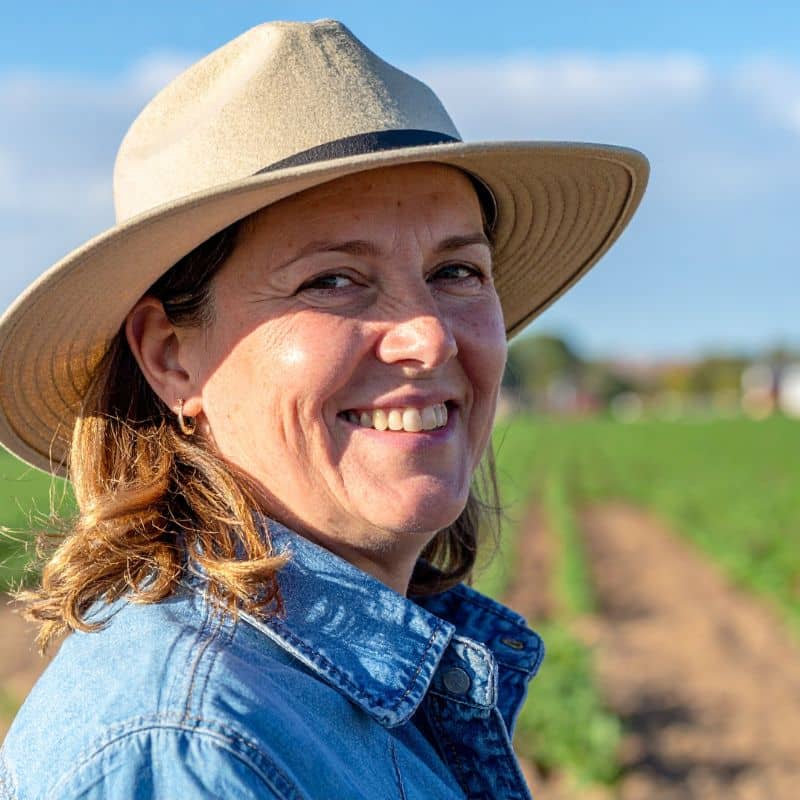
Co-Founder at Homesteading Simple | Horticulture & Sustainable Living Educator | 25 Years in Practical Homesteading

